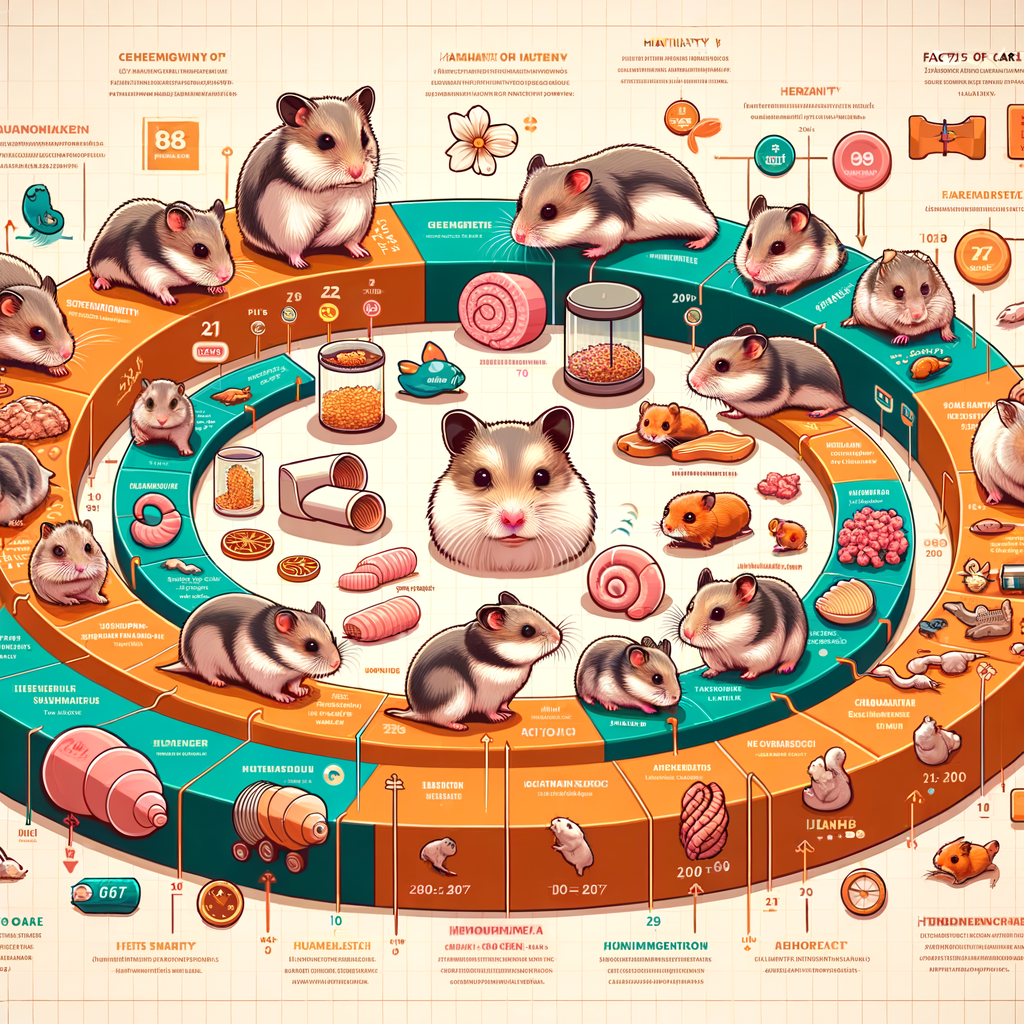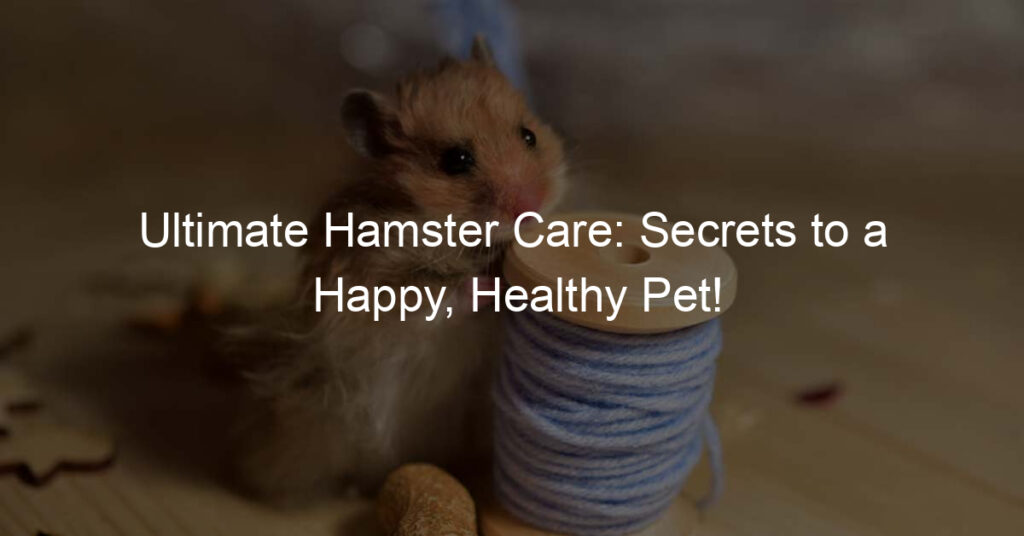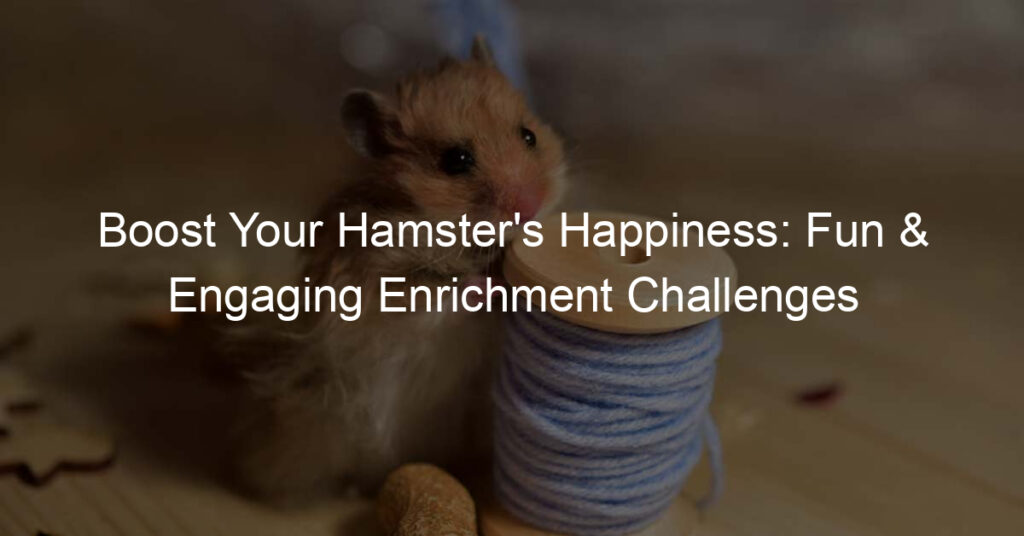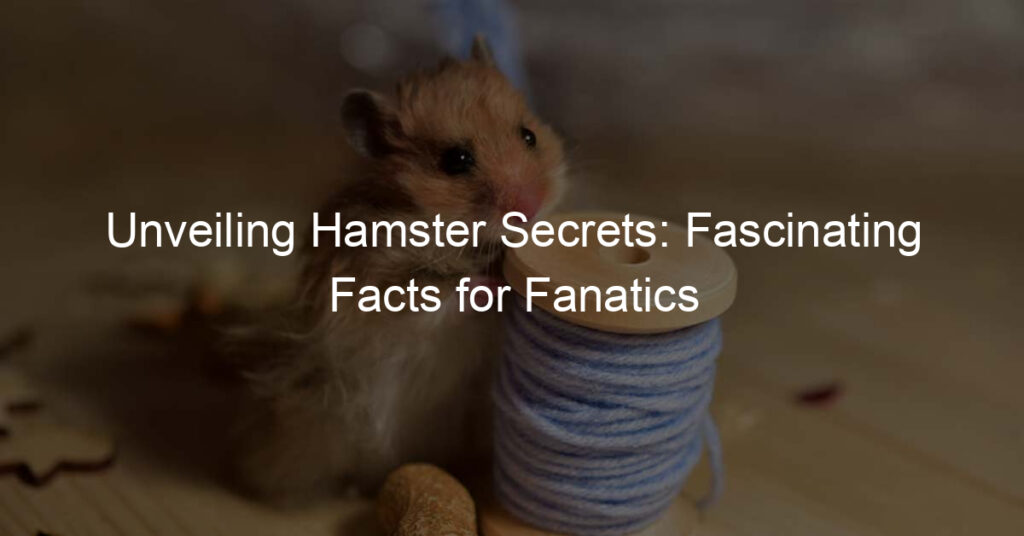
Introduction to Hamster Lifespan
Hamsters are adorable, small creatures that have become popular pets worldwide. But how long do these furry friends live? In this section, we will delve into the lifespan of hamsters, helping you understand their life expectancy and the factors that influence it.
- Understanding the life expectancy of hamsters
- Factors that influence a hamster’s lifespan
On average, a hamster’s lifespan ranges from 2 to 3 years. However, this can vary based on the species of the hamster. The Roborovski Dwarf hamster, for instance, has a longer lifespan of 3 to 3.5 years, while the larger Syrian hamster typically lives for 2 to 2.5 years. It’s important to note that these are average figures, and individual hamsters may live slightly shorter or longer lives depending on various factors.
Several factors can influence a hamster’s lifespan. These include:
| Factor | Explanation |
|---|---|
| Diet | A balanced diet rich in fruits, vegetables, and high-quality hamster food can contribute to a longer lifespan. |
| Exercise | Regular exercise, such as running on a wheel or through a maze, helps keep hamsters healthy and can extend their lifespan. |
| Genetics | Just like humans, some hamsters may be genetically predisposed to live longer than others. |
| Care | Proper care, including regular vet check-ups and a clean living environment, can greatly impact a hamster’s lifespan. |
Understanding these factors can help you provide the best care for your hamster, potentially extending its life and ensuring it is happy and healthy.
Hamster Life Cycle
Understanding the life cycle of a hamster can help you provide the best care for your furry friend. Let’s explore the different stages of a hamster’s life.
Hamster Growth Stages
There are four main stages in a hamster’s life. Let’s take a closer look at each one.
- Birth to Weaning
- Juvenile Stage
- Adulthood
- Senior Stage
Hamsters are born hairless and blind. After about two weeks, they start to grow fur and open their eyes. By the time they are three weeks old, they are weaned from their mother and start eating solid food.
This is the stage where hamsters grow rapidly. They are very active and curious during this time. It’s important to provide them with plenty of exercise and mental stimulation.
Hamsters reach adulthood at around 8 weeks old. This is when they are fully grown and their behavior becomes more stable. Adult hamsters need a balanced diet and regular exercise to stay healthy.
Hamsters enter their senior stage at around 18 months old. They may become less active and require more rest. It’s important to monitor their health closely during this stage.
Knowing these stages can help you understand your hamster’s needs and behavior at different times in their life. Remember, every hamster is unique and may develop at a slightly different pace.
Hamster Development
As hamsters grow, they undergo various changes. These changes are not just physical but also behavioral. Let’s delve into these transformations.
- Physical changes in hamsters
- Behavioral changes in hamsters
Hamsters, like all living creatures, experience physical changes as they grow. These changes can be fascinating to observe. Let’s explore some of them.
When hamsters are born, they are hairless, and their eyes and ears are closed. However, within a week, they start developing fur. By the time they are two weeks old, their eyes and ears open, and they begin to look like mini versions of adult hamsters.
As they transition into the juvenile stage, their bodies grow rapidly. They develop sharp teeth for gnawing and strong legs for running. Their fur becomes thicker and shinier, and their cheek pouches become more pronounced.
Upon reaching adulthood, hamsters attain their full size. The males are generally larger than the females. Their fur may change color slightly, and they may gain or lose weight depending on their diet and exercise.
In the senior stage, hamsters may show signs of aging such as graying fur, decreased activity, and weight loss. They may also develop health issues like arthritis or dental problems.
Hamsters also exhibit behavioral changes as they grow. These changes can give us insights into their health and happiness.
Newborn hamsters are entirely dependent on their mother for warmth and food. However, as they grow, they start exploring their surroundings and become more independent.
During the juvenile stage, hamsters are very active and curious. They love to run on their wheel, explore their cage, and play with toys. They also start hoarding food in their cheek pouches.
Adult hamsters have a well-established routine of sleeping during the day and being active at night. They are territorial and may show aggression if their space is invaded. They also show interest in mating.
Senior hamsters tend to be less active and sleep more. They may also show signs of confusion or forgetfulness. However, they still enjoy gentle handling and simple activities.
Understanding these physical and behavioral changes can help us take better care of our hamsters at each stage of their life.
Hamster Care
One of the most crucial aspects of hamster care is ensuring they receive proper nutrition. This involves understanding the importance of a balanced diet and knowing what foods are best for your furry friend.
Proper Nutrition
Just like humans, hamsters thrive on a balanced diet. It’s not just about filling their bellies, but also about providing them with the nutrients they need for a healthy life.
- Importance of a Balanced Diet
- Recommended Foods for Hamsters
A balanced diet for your hamster is essential for several reasons. It helps maintain their energy levels, supports growth, and aids in digestion. Moreover, a well-rounded diet can help prevent diseases and extend your hamster’s lifespan.
Hamsters are omnivores, which means they eat both plants and meat. Their diet should include a mix of fruits, vegetables, grains, and protein. Some recommended foods for hamsters include:
| Fruits | Vegetables | Grains | Protein |
|---|---|---|---|
| Apples (no seeds) | Carrots | Whole grain bread | Boiled eggs |
| Bananas | Broccoli | Brown rice | Chicken (cooked) |
| Pears (no seeds) | Cucumbers | Oats | Tofu |
Remember, all foods should be given in moderation and certain foods like almonds, citrus fruits, and onions should be avoided as they can be harmful to hamsters.
Exercise and Stimulation
Just like humans, hamsters also need regular exercise and stimulation to stay healthy and happy. Let’s explore why physical activity is important for your hamster and what toys and exercises are recommended.
- Importance of Physical Activity
Physical activity is crucial for your hamster’s health. It helps to keep their heart strong, maintain a healthy weight, and prevent boredom. Hamsters are naturally active creatures. In the wild, they travel long distances in search of food. So, a lack of physical activity can lead to health issues like obesity and heart disease. Moreover, it can also lead to behavioral problems as the hamster may become bored and stressed.
- Recommended Toys and Exercises
There are many ways to ensure your hamster gets enough exercise and stimulation. Here are some recommended toys and exercises:
- Exercise Wheel: An exercise wheel is a must-have for every hamster cage. It allows your hamster to run and stay active, even when it’s inside the cage.
- Hamster Ball: A hamster ball allows your hamster to explore outside its cage safely. It’s a great way to give your hamster some exercise and stimulation.
- Mazes and Tunnels: Hamsters love to burrow and explore. You can create mazes and tunnels using cardboard or buy them from a pet store. This will provide your hamster with both physical exercise and mental stimulation.
- Chew Toys: Chew toys are great for keeping your hamster’s teeth healthy. They also provide a good source of entertainment for your hamster.
Remember, each hamster is unique and may have different preferences. Try different toys and exercises to see what your hamster enjoys the most. Always supervise your hamster during playtime to ensure its safety.
In conclusion, regular exercise and stimulation are vital for your hamster’s overall health and well-being. By providing the right toys and exercises, you can ensure your hamster stays active, healthy, and happy.
Hamster Health
Just like humans, hamsters also have health needs that must be met. Understanding these needs is essential to ensure your furry friend lives a long and healthy life. In this section, we will discuss some common health issues that hamsters face, how to identify signs of illness, and when it’s time to seek veterinary care.
Common Health Issues
Hamsters are generally healthy pets, but they can sometimes experience health issues. Some of the most common health problems in hamsters include wet tail disease, respiratory infections, and skin conditions. Let’s delve into how you can identify signs of these illnesses and know when to seek professional help.
- Identifying signs of illness
- When to seek veterinary care
Observing your hamster’s behavior is crucial in identifying signs of illness. Changes in eating habits, lethargy, and unusual behavior can all be signs that something is wrong. For example, a hamster with wet tail disease may have a wet and soiled rear end, while a hamster with a respiratory infection may have difficulty breathing or discharge from the nose and eyes. Skin conditions can cause hair loss, redness, or sores on the skin.
If you notice any signs of illness in your hamster, it’s essential to seek veterinary care as soon as possible. Early detection and treatment can make a significant difference in your hamster’s recovery. Remember, it’s always better to be safe than sorry when it comes to your pet’s health.
Understanding your hamster’s health needs is crucial to providing them with the best care possible. By being aware of common health issues, knowing how to identify signs of illness, and understanding when to seek veterinary care, you can help ensure your hamster lives a long, healthy, and happy life.
Aging in Hamsters
As your pet hamster grows older, it’s important to understand the changes they go through and how to provide the best care. Let’s dive into the aging process of hamsters and how to care for them during this stage.
-
Understanding the Aging Process
Hamsters, like all living creatures, go through an aging process. This process is marked by a gradual decline in physical and mental capabilities. Hamsters typically live for 2-3 years, and they start showing signs of aging around their second year.
Some signs of aging in hamsters include less energy, slower movements, and changes in eating habits. They may also develop age-related health issues, such as arthritis or kidney problems. It’s important to observe your hamster closely as they age to identify any changes in their behavior or appearance.
Signs of Aging Description Less Energy Hamsters may become less active and sleep more. Slower Movements They may move slower due to joint stiffness or pain. Changes in Eating Habits They may eat less or show less interest in food. -
How to Care for an Aging Hamster
Caring for an aging hamster requires patience and understanding. Here are some tips to help you provide the best care for your aging pet:
- Provide a Comfortable Habitat: Make sure your hamster’s cage is easy for them to navigate. Avoid high platforms that they could fall from.
- Offer a Balanced Diet: A diet rich in fiber and low in fat can help keep your hamster healthy. Consult with a vet for dietary recommendations.
- Regular Vet Check-ups: Regular vet visits can help catch any health issues early. Your vet can provide advice on managing any age-related conditions.
Remember, every hamster is unique and may age differently. Always observe your pet and adjust their care as needed.
Hamster Lifespan Stages
Understanding the lifespan stages of your hamster is crucial to providing them with the best care possible. Hamsters go through several distinct stages in their life, each with its own unique needs and signs. Let’s delve into each stage and learn how to care for your hamster during these times.
Understanding Each Stage
Hamsters typically go through four main stages in their life: infancy, adolescence, adulthood, and seniority. Each stage has its own set of signs and care requirements.
- Signs of each stage
- How to care for hamsters at each stage
Infancy is characterized by rapid growth and development. Adolescent hamsters are very active and playful. As adults, they are less active but still require stimulation and exercise. Senior hamsters may show signs of slowing down and may have health issues.
During infancy, provide a diet rich in protein to support growth. Adolescents need plenty of exercise and mental stimulation. Adult hamsters require a balanced diet and regular exercise, while senior hamsters may need special care and more frequent vet check-ups.
Understanding these stages and their signs will help you provide the best care for your hamster throughout their life. Remember, each hamster is unique and may not follow these stages exactly. Always observe your hamster’s behavior and consult with a vet if you notice any changes.
| Stage | Signs | Care |
|---|---|---|
| Infancy | Rapid growth | High-protein diet |
| Adolescence | High activity | Exercise and stimulation |
| Adulthood | Less active | Regular exercise and balanced diet |
| Seniority | Slowing down, possible health issues | Special care, frequent vet check-ups |
In conclusion, understanding the lifespan stages of your hamster is crucial to providing them with the best care possible. By recognizing the signs of each stage and adjusting their care accordingly, you can help ensure your hamster lives a long, healthy, and happy life.
Conclusion: Maximizing Your Hamster’s Lifespan
As we reach the end of our comprehensive guide on hamster lifespan, it’s essential to summarize the key points and takeaways. The lifespan of a hamster can be significantly influenced by the care they receive, their diet, and their overall health. Let’s recap the crucial points to remember.
- Key takeaways for hamster care
- Final thoughts on hamster lifespan
Hamster care is a fundamental aspect of ensuring a long and healthy life for your furry friend. Remember to provide a clean, spacious habitat with plenty of opportunities for exercise and mental stimulation. A balanced diet rich in fruits, vegetables, and high-quality hamster food is also crucial. Regular vet check-ups can help detect any potential health issues early, increasing the chances of successful treatment.
Hamsters, like all living creatures, have a finite lifespan. However, with proper care, a balanced diet, and regular health check-ups, you can help maximize their lifespan. Remember, a happy hamster is a healthy hamster, and a healthy hamster is likely to live a longer life. Let’s cherish the time we have with our little companions and provide them with the best care possible.
In conclusion, the lifespan of a hamster is not just determined by genetics but also by the quality of care they receive. By following the guidelines discussed in this article, you can ensure that your hamster lives a happy, healthy, and long life.








